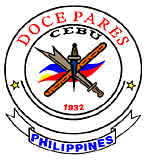The 'Doce Pares' is an Escrima/Arnis Martial Arts Club that was founded in Cebu City in January 12, 1932. Originally it was a breakaway group of students and instructors from the 'Labangon Fencing Club' of the 1920's which was influenced heavily by the Saavedra and Cañete families. The original instructors of the Doce Pares taught their own particular families, island's or region's styles of Escrima and their particular interpretation of their own styles. The Doce Pares was made famous in the international scene during the 60's, 70's, 80's and 90's by the Cañete family, especially Ciriaco 'Cacoy' Cañete and later by his nephew Dionisio 'Diony' Cañete.
The term 'Doce Pares' is a Spanish term translated into English to mean 'Twelve Pairs'. This term the 'Twelve Pairs' has been given several meanings to it. One refers to the twelve basic strikes that are common to most Escrima styles and schools and their twelve basic block and counters to these strikes. Another more romantic explanation is of the reference to the twelve pairs of 'Compadres', the bodyguards for the King Charlemagne and how the club should emulate the friendship of these warriors. The final explanation is that supposedly there were twelve original master members of the club.
There are no Grandmasters alive from the original founding members of the Doce Pares. However there are several senior instructors or Grandmasters of the second generation of Escrimadors/Arnisadors still alive that teach their own interpretation or styles of Escrima/Arnis within the club the Doce Pares.
The styles that are taught within the Visayan Martial Arts school that come from the Doce Pares are from; Ciriaco 'Cacoy' Cañete and his family, Victor Cagadas and Celso Amora Mabalhin.
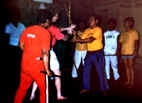
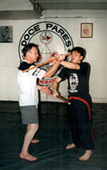 Ciriaco Cañete
or 'Cacoy' as he is known by his Filipino nickname, was born in August
1919 in San Fernando approximately 30 kilometres south of Cebu City, on
Cebu Island, in the Visayas region of The Philippines. He was the youngest
of twelve children. At the early age of seven he was initiated into Escrima,
learning from his brother Filemon or "Momoy" who had in turn
learnt Escrima from his father Gregorio and uncles Gavino, Pedro (from
his fathers family) and Juancho (from his mothers family). Because of
his open mindedness and desire for knowledge, he has trained in many different
styles of Martial Arts. Some of the styles he has learnt include Jui Jitsu,
Boxing, Kodokan Judo, free style wrestling, Shorin Karate and Aikido.
With his acknowledged spectrum of skills through his lifetime of training,
he has gained a deep insight and a broad understanding, with mastery of
the concepts of self defence and combat. The culmination of years of learning
fused into the style that he teaches which is called 'Escrido'.
This style combines the refined essential elements of every martial art
he has learnt through his life.
Ciriaco Cañete
or 'Cacoy' as he is known by his Filipino nickname, was born in August
1919 in San Fernando approximately 30 kilometres south of Cebu City, on
Cebu Island, in the Visayas region of The Philippines. He was the youngest
of twelve children. At the early age of seven he was initiated into Escrima,
learning from his brother Filemon or "Momoy" who had in turn
learnt Escrima from his father Gregorio and uncles Gavino, Pedro (from
his fathers family) and Juancho (from his mothers family). Because of
his open mindedness and desire for knowledge, he has trained in many different
styles of Martial Arts. Some of the styles he has learnt include Jui Jitsu,
Boxing, Kodokan Judo, free style wrestling, Shorin Karate and Aikido.
With his acknowledged spectrum of skills through his lifetime of training,
he has gained a deep insight and a broad understanding, with mastery of
the concepts of self defence and combat. The culmination of years of learning
fused into the style that he teaches which is called 'Escrido'.
This style combines the refined essential elements of every martial art
he has learnt through his life.
Ciriaco Cañete's Escrido Doce Pares syllabus:
Single, double stick, and stick/dagger single person patterns or katas. Ammara/ Pinki Pinki double stick training routines or drills sometimes called Sinawali in the northern regions of the Philippines. Breakfalls and throws. Stick and dagger defence, locks and throws. Semi free sparring in close, medium and long range with single stick and stick and dagger. Disarms are one of Cacoy's main emphasis.

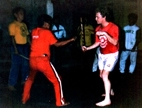 Cacoy's
Twelve Basic strikes; #1 top of head, #2
right temple, #3 left temple, #4 right ribs,
#5
left ribs, #6 right waist, #7 left
waist, #8 right knee, #9 left knee, #10 right
face thrust, #11 left face thrust, #12 stomach
thrust.
Cacoy's
Twelve Basic strikes; #1 top of head, #2
right temple, #3 left temple, #4 right ribs,
#5
left ribs, #6 right waist, #7 left
waist, #8 right knee, #9 left knee, #10 right
face thrust, #11 left face thrust, #12 stomach
thrust.
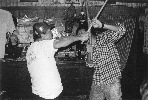
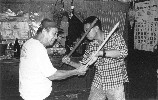 Victor
Cagadas
was born on January 22nd 1924 in Bohol Island the Philippines. His martial
arts training began when he was a boy of ten years.
His father and uncles were his instructors and they taught him their various
styles and systems of Escrima. As a young man he apprenticed as a tailor
and in 1945 he moved from Bohol Island to Cebu City to set up a tailoring
business. His brothers Macanio, Ireneo and Pelecinimo were living in Cebu
City at the time and were also skilled in Escrima. All four brothers were
invited to join the Doce Pares. In 1946 Victor's three brothers accepted
but Victor declined due to heavy work commitments. In 1951 after having
established his tailoring business Victor accepted the invitation to join
the Doce Pares Club. During the ensuing decades he taught privately and
to a limited extent publicly his unique family system of Escrima.
He referred to his
style simply as 'Cagadas' or 'Cagadas Doce Pares' and later in his life
called his style 'Black Dragon Escrima'.
Victor
Cagadas
was born on January 22nd 1924 in Bohol Island the Philippines. His martial
arts training began when he was a boy of ten years.
His father and uncles were his instructors and they taught him their various
styles and systems of Escrima. As a young man he apprenticed as a tailor
and in 1945 he moved from Bohol Island to Cebu City to set up a tailoring
business. His brothers Macanio, Ireneo and Pelecinimo were living in Cebu
City at the time and were also skilled in Escrima. All four brothers were
invited to join the Doce Pares. In 1946 Victor's three brothers accepted
but Victor declined due to heavy work commitments. In 1951 after having
established his tailoring business Victor accepted the invitation to join
the Doce Pares Club. During the ensuing decades he taught privately and
to a limited extent publicly his unique family system of Escrima.
He referred to his
style simply as 'Cagadas' or 'Cagadas Doce Pares' and later in his life
called his style 'Black Dragon Escrima'.
Victor Cagadas' Black Dragon Doce Pares syllabus:
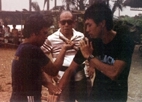
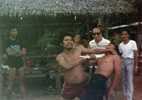 Quite different from the mainstream
Doce Pares as he has no twelve basic strikes but uses the basic theory
of two angles of attack and defence. Whether the strike is a slash, thrust
or a butt his attitude is that the strikes only come from two sides, the
left or the right, the backhand or the forehand. If the strike is delivered
down the imaginary centre line the student simply steps, twists or body
angles to one side or the other side. Victor teaches Ammara and Sinawali
like many of the Doce Pares. He teaches mainly a double stick style but
emphasises the single stick and empty hand principles. He also teaches
his families special Boholian knife fighting techniques. The style has
no semi free sparring. Simply block, lock or disarm and counter an opponent.
The fight is over in an instant. Victor was eventually banned from taking
part in Doce Pares matches and sparring sessions because of his aggressive
manner during these matches and of his attitude in general towards the
trend of free sparring/sport Escrima. After several incidents and disagreements
of what some would call over exuberant striking and force he eventually
lost patience and smashed another instructors nose with the butt of his
stick.
Quite different from the mainstream
Doce Pares as he has no twelve basic strikes but uses the basic theory
of two angles of attack and defence. Whether the strike is a slash, thrust
or a butt his attitude is that the strikes only come from two sides, the
left or the right, the backhand or the forehand. If the strike is delivered
down the imaginary centre line the student simply steps, twists or body
angles to one side or the other side. Victor teaches Ammara and Sinawali
like many of the Doce Pares. He teaches mainly a double stick style but
emphasises the single stick and empty hand principles. He also teaches
his families special Boholian knife fighting techniques. The style has
no semi free sparring. Simply block, lock or disarm and counter an opponent.
The fight is over in an instant. Victor was eventually banned from taking
part in Doce Pares matches and sparring sessions because of his aggressive
manner during these matches and of his attitude in general towards the
trend of free sparring/sport Escrima. After several incidents and disagreements
of what some would call over exuberant striking and force he eventually
lost patience and smashed another instructors nose with the butt of his
stick.
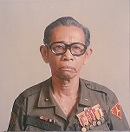 Celso
Amora Mabalhin was born in the small town of Anhawan Southern Leyte
on April 6, 1923. His Arnis/Escrima training began when he was a small
boy of 7. He was taught by his grandfather Bernado Mabalhin, in the Waray
Waray Bolo/Pinute style.
At the age of 12 he began to learn the "Pinayong" or "Umbrella"
style from a Boholano trader with whom Celso worked for, selling cloths
on the island of Samar. The rattan poles used in carrying the bundles
of cloths were used as the teaching instruments.
Celso
Amora Mabalhin was born in the small town of Anhawan Southern Leyte
on April 6, 1923. His Arnis/Escrima training began when he was a small
boy of 7. He was taught by his grandfather Bernado Mabalhin, in the Waray
Waray Bolo/Pinute style.
At the age of 12 he began to learn the "Pinayong" or "Umbrella"
style from a Boholano trader with whom Celso worked for, selling cloths
on the island of Samar. The rattan poles used in carrying the bundles
of cloths were used as the teaching instruments.
During WW2 he was a guerilla fighter serving as a 2nd lieutenant.
In 1953 he came to Cebu to establish a photography business, which became the well known US Studio. During this year he was invited to join the Doce Pares group of Cebu.
His main sparring partner/teacher in the Doce Pares was Filemon "Momoy" Canete, a master in Espada y Daga. His training in Martial Arts did not stop here at the Doce Pares however. He also broke club barriers by training with Venancio "Anciong" Bacon a master in Tapi Tapi, a one time member of the Doce Pares but had broken away to form his own school, "Balintawak". Another of his long time instructors during this period was Jesus "Pops" Cui SR, a master in Jui Jitsu.
In the early 60's he underwent Kudokan Judo training with the supervision of Mr Y. Heroshi. He was joined in Judo training by Cacoy Canete, Bebe Roa, DR Laraquel and Maning rivera to name but a few. He also underwent training in amateur wrestling with Sgt. Alcarez, a onetime Philippine army national champion and also Ai Ki Do with Max Tian.

 In
1962 he founded the Kamagayan Judo Club where his students went on to
win medals in a series of local and national tournaments.
In
1962 he founded the Kamagayan Judo Club where his students went on to
win medals in a series of local and national tournaments.
In 1963 he traveled
to the United States of America to further his studies in colour photography.
He then proceeded through California to teach Martial Arts and Escrima.
Back in Cebu
in 1966 he founded the "Cebu Empty Hands Karate Club" with the
supervision and training of Master Johnny Chiuten then President of the
"Philippines Karate Federation". He then received numerous medals
and awards as best Judoist, best fencer, best in Jui Jitsu, best for Bojitsu
in competitions for several years. In 1968-69 students and the children
of Celso, Celso JR, Floro and Thomas participated in SPAJA (Southern Philippines
Amateur Judo Association) tournaments winning medals in different category's
during different tournaments.
In 1970 he was awarded a Masters Degree Red Belt from the Kempo Karate Club, Honolulu, Hawaii. During the 70's Celso and his children actively participated in the National Arnis Association of the Philippines (NARAPHIL). Celso demonstrated the Waray Waray style of Bolo/Pinute defences. In 1974 he introduced the "ESCRIBO" or Escrima Boxing for tournament consideration. The then NARAPHIL President Gen. Fabian Ver, appreciated the ESCRIBO and wanted to promote it but the majority of NARAPHIL went for the armor alternative.
During the 1980's, his active participation, teaching and promotion of the Doce Pares Club of Cebu, resulted in the awarding in 1989, of an 11th degree Red & White Grandmasters belt, from Momoy and Yuling Canete. During the late 80's, his old friend Jesus (Pops) Cui SR came to live his final years at Celso's Junquera street residence, teaching Celso advanced Jui Jitsu, especially the nerve center attack techniques.
In 1991 he was promoted Major in the Philippines Armed Forces Reservist and throughout the 90's taught students his different Arnis/Escrima styles.
On May 6th 2000 he passed away hoping his Martial Arts legacy would be continued by his children and students.
| Home | seminars | balintawak | doce pares | tat kun tao | VMA instructors | travel pics | articles | FMA instructors | downloads | email | links |
©1998-2003 John Russell
